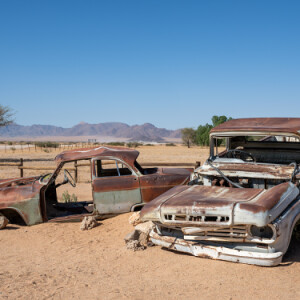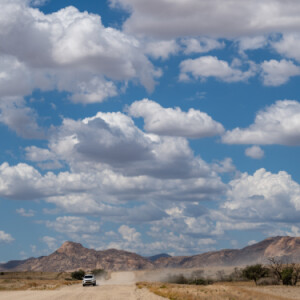Namibia day 5 - Quiver trees
We had breakfast, packed up and left the lodge by 8am. An hour into our journey saw us at Soltaire which has fuel, a trading store, cafe and a bakery well known for its apple pie and meat pies, none of which I can eat but some were purchased for our picnic lunch (I had made a GF sandwich before we left the lodge). Actually no one in the family really likes pies so some sandwiches were also bought. They also had a bit of a derelict car graveyard which was worthy of a few photos (see first extra). They had a board up displaying the rainfall for the past 15 years - so far they have only had 3mm in 2024 and as we are at the end of their rainy season that is very worrying.
The scenery on the road to Swakopmund was so scenic, not the green beauty of the U.K. but very dry with fascinating rock strata in the mountains surrounding us - dolorite, granite, magnetite, quartz, basalt. Going through Kuiseb Pass was incredible. The roads are all dirt roads but in excellent condition as there are workers smoothing out the roads with graders 24/7. On the Kuineb Pass they were actually tarring the road as it is quite steep and winding, so the better surface should be easier. As Toni joked, for this journey women need to wear a sports bra and false teeth need to be taken out!
We had a picnic lunch at a roadside picnic table where it was about 33C. Earlier we had reached 39C but as we approached Swakopmund the temperature started to drop. It is much cooler at the coast which is why it is so popular in the peak of their summer months.
We stopped off to photograph some quiver trees, probably the most northern place to find them as they grow in the south. On the original photography trip we were going to the quiver tree forest near Luderitz and also Kolmanskop, the abandoned houses filled with sand, but it is much further south and we decided to rather go to Swakopmund and then north to see wildlife, so I was pleased to see the trees here. Quiver trees are part of the aloe family, and are so named because the San people used their branches as quivers to carry their arrows. It is critically endangered and only grows in the small area of Namibia and northern South Africa.
When we crossed the Tropic of Capricorn we had to take the obligatory shots of us at the sign.
We also stopped to see the Welwitschia plant which is the national plant of Namibia and is only found in the Namib desert (see last extra). It is a peculiar plant with only two leaves growing out of a central cone, male plants being different from female. They are about 500-600 years old but larger ones can be 2000 years old. The conditions in which they grow makes them have a low pollination rate.
We reached Swakopmund at about 4pm and checked into our base for the next two nights, the Strand Hotel. It is located overlooking the sea and is quite lovely. The temperature had dropped to about 19C and it is very windy here. Tomorrow is forecast to be 17C with mist, what a change from the desert.




Comments
Sign in or get an account to comment.


